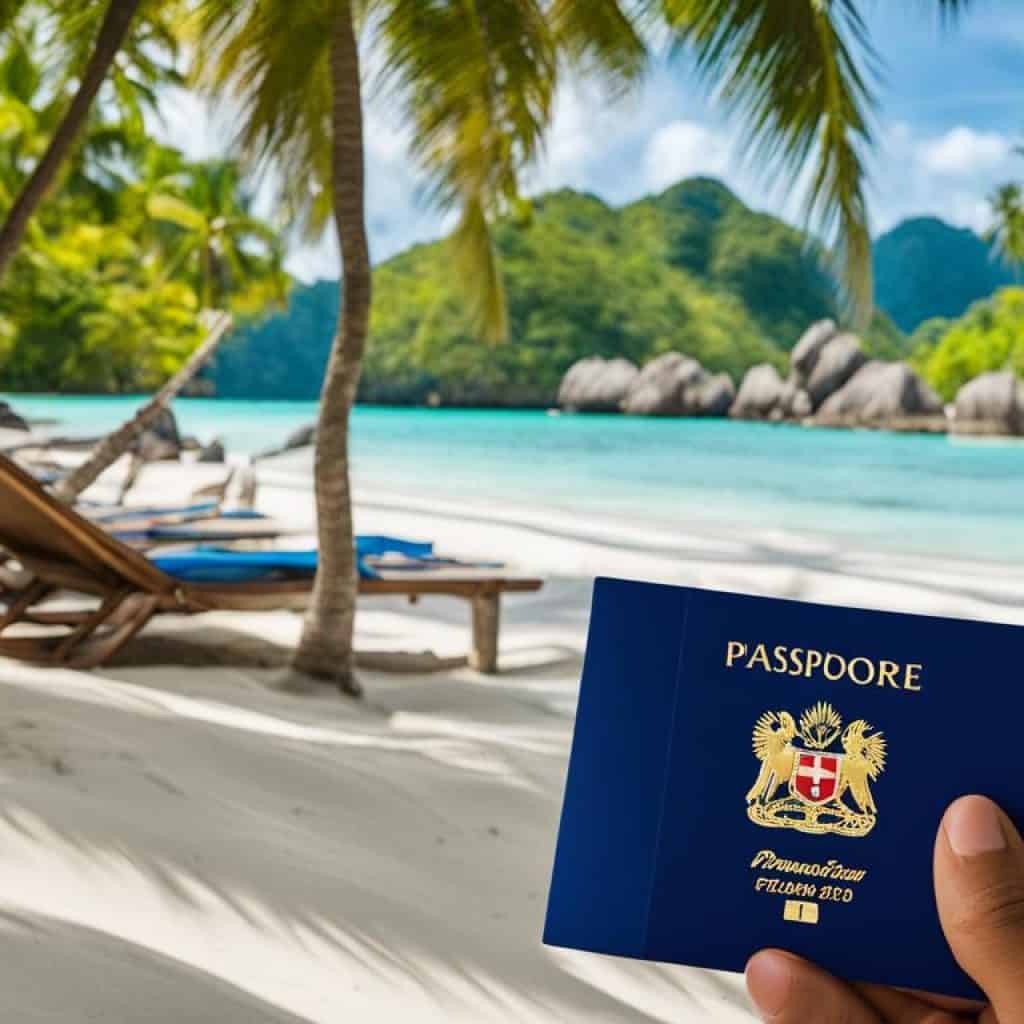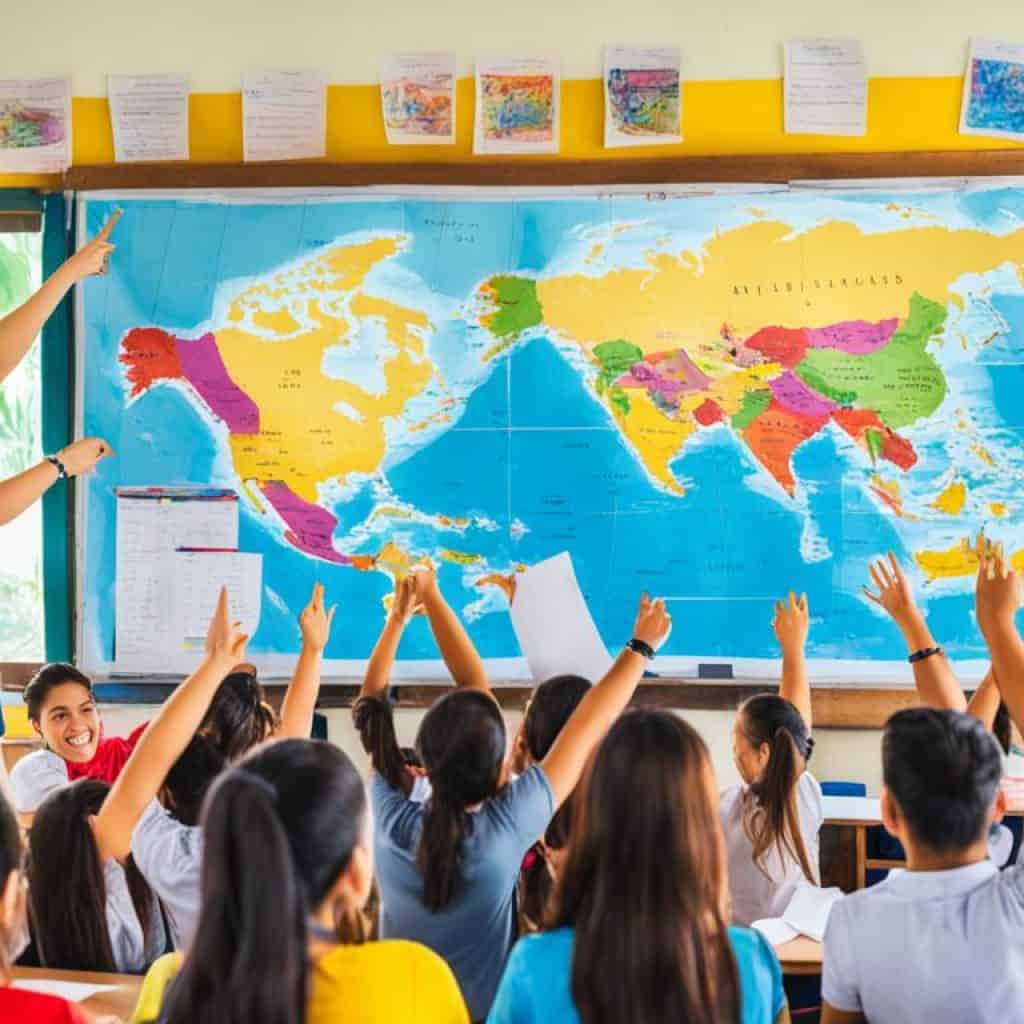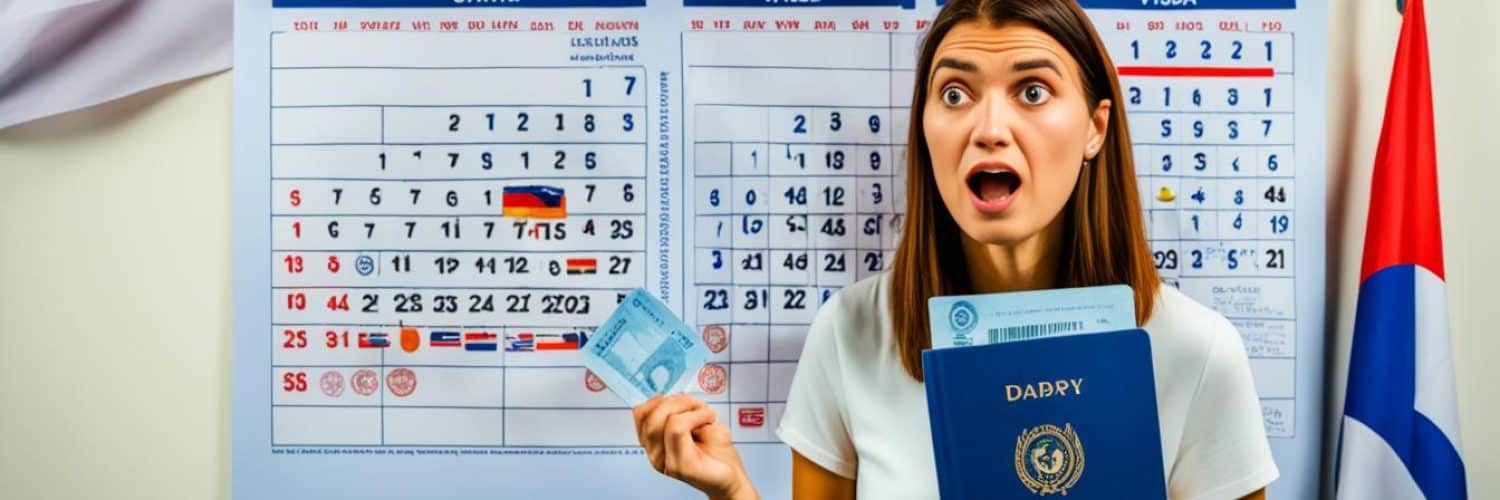Are you an American citizen considering a move to the Philippines? Perhaps you’re planning a long-term stay or wondering about the visa requirements and duration. How long can an American actually stay in the Philippines without facing any legal issues? Let’s explore the answers to these questions and more.
The duration of your stay in the Philippines as an American citizen depends on the type of visa you hold. If you’re visiting as a tourist, you can stay for up to 30 days without a visa. But what if you want to stay longer? What are the visa requirements and rules for American citizens in the Philippines? Let’s dive into the details to ensure your stay in the Philippines is both legal and enjoyable.
Key Takeaways:
- As an American citizen, you can visit the Philippines as a tourist for up to 30 days without a visa.
- If you plan to stay longer, you’ll need to apply for a long-stay visa and meet specific requirements set by the Philippine government.
- The duration of a tourist visa in the Philippines is typically 30 days, but you can extend it by applying for an extension at the Bureau of Immigration.
- American citizens staying in the Philippines must abide by the visa rules and regulations set by the Philippine government.
- If you’re considering permanent stay, retirement, work, or study in the Philippines, there are specific visa requirements and processes to follow.
Visa Requirements for American Citizens in the Philippines
Planning to stay in the Philippines for more than 30 days? As an American citizen, you’ll need to apply for a long-stay visa to ensure a smooth and legal stay in the country. The specific visa requirements and application process can vary depending on the purpose of your visit, whether it’s for work, study, retirement, or joining a family member.
It’s crucial to research and understand the specific visa requirements in advance, so you can gather all the necessary documents and complete the application correctly. By being well-prepared, you can reduce any potential delays or complications during the visa application process.
Whether you’re exploring the vibrant culture, beautiful beaches, or pursuing career opportunities in the Philippines, understanding the visa requirements is essential for a successful stay in the country.
“A well-prepared visa application will increase your chances of obtaining the necessary visa for your stay in the Philippines.”
Types of Visas for American Citizens
American citizens have various visa options available depending on their purpose of visit. Here are some common types of visas:
- Tourist Visa: If you’re visiting the Philippines for leisure or tourism purposes, you can apply for a tourist visa. This visa allows you to stay for up to 30 days without the need for an extension.
- Student Visa: If you plan to study in the Philippines, you’ll need to apply for a student visa. This visa allows you to enroll in a recognized educational institution in the country.
- Work Visa: If you have a job offer or plan to work in the Philippines, you’ll need to obtain a work visa. The requirements for a work visa may vary depending on the nature of your job and the length of your stay.
- Retirement Visa: If you’re considering retiring in the Philippines, you can apply for a retirement visa, known as the Special Resident Retiree’s Visa (SRRV). This visa offers various benefits and privileges to retirees.
It’s important to note that each visa type has its specific requirements and application process. Therefore, it’s advisable to consult with the Philippine Embassy or Consulate to get accurate and up-to-date information based on your individual circumstances.
Preparing Your Visa Application
When applying for a visa as an American citizen, it’s vital to ensure that your application is complete and accurate. Here are a few key points to consider:
- Familiarize yourself with the specific visa requirements and gather all necessary documents.
- Fill out the visa application form accurately and provide all requested information.
- Submit any supporting documents required, such as a valid passport, proof of accommodation, financial statements, or a letter of invitation.
- Double-check all the information before submitting your application to avoid any errors or omissions that could lead to delays or rejections.
Remember, a well-prepared visa application will increase your chances of obtaining the necessary visa for your stay in the Philippines. It’s always advisable to start the visa application process well in advance to allow sufficient time for processing and to address any potential issues that may arise.
Tourist Visa Duration in the Philippines
Planning a trip to the Philippines as an American tourist? It’s important to understand the duration of a tourist visa to ensure a smooth and hassle-free visit. Typically, a tourist visa allows American citizens to stay in the country for up to 30 days without the need for a visa. This provides plenty of time to explore the beautiful beaches, vibrant cities, and rich cultural heritage that the Philippines has to offer.
If you’re looking to stay longer and continue your adventure, don’t worry! You have the option to extend your tourist visa by applying for an extension at the Bureau of Immigration in the Philippines. This will grant you an additional 29 or 59 days, depending on the specific extension option you choose. With this extension, you can make the most of your time and fully immerse yourself in the wonders of this tropical paradise.
Whether you’re seeking relaxation on pristine shores, eager to embark on thrilling adventures, or eager to soak in the local culture, knowing the tourist visa duration and extension options will ensure a memorable experience in the Philippines.
Embark on your Philippine journey today and make the most of your time in this breathtaking destination. Let the warm hospitality and natural beauty captivate your senses as you embrace the diversity and charm of the Philippines.
Visa Process for American Citizens in the Philippines
Planning to visit or stay in the Philippines as an American citizen? Understanding the visa process is crucial to ensure a smooth and hassle-free experience. To help you navigate through the application process, here’s an overview of what you need to know.
Submitting Your Visa Application
When applying for a visa, you will need to submit the necessary documents to the Philippine Embassy or Consulate. The specific requirements may vary depending on the type of visa you are applying for. It is essential to carefully review the instructions provided by the Philippine government to ensure you have all the required documents before submitting your application.
Completing the Application Form
Along with the required documents, you will also need to fill out the visa application form. The form can be obtained from the Philippine Embassy or Consulate or downloaded online. Make sure to provide accurate and truthful information when completing the form to avoid any delays or complications in the visa processing.
Processing Time
The processing time for visa applications can vary depending on various factors, including the type of visa and the volume of applications received. It is advisable to submit your visa application well in advance to allow sufficient time for processing. Planning ahead and applying early will help ensure that you receive your visa in a timely manner, leaving you with ample time to prepare for your trip to the Philippines.
| Common Documents Required for Visa Application: | Additional Documents (Varies Depending on Visa Type): |
|---|---|
|
|
Remember to check with the Philippine Embassy or Consulate for the most up-to-date and specific requirements for your visa application.
By carefully following the visa process and ensuring that you have all the necessary documents, you can enhance your chances of obtaining a visa to the Philippines and enjoy your time exploring the beautiful islands and experiencing the rich culture of the country.
Visa Extension in the Philippines
If you wish to prolong your stay in the Philippines beyond the initial duration of your visa, you have the option to apply for a visa extension. This allows you to enjoy more time in this beautiful country and explore its wonders at your leisure. The visa extension process is straightforward, and by following the necessary steps, you can easily extend your stay and make the most of your time in the Philippines.
Applying for a Visa Extension
To initiate the visa extension process, you will need to visit the Bureau of Immigration in the Philippines. There, you will be required to provide the necessary documents and make the payment for the extension fee. The specific documents required may vary based on the type of visa you hold, so it’s important to verify the requirements beforehand to ensure a smooth application process.
During your visit, you will need to complete the visa extension application form and submit any additional supporting documents as requested. This may include your passport, proof of financial capability, and a valid reason for requesting the extension. It’s crucial to prepare all the required documents in advance to avoid any delays or complications in the process.
Duration of Visa Extension
The duration of the visa extension granted depends on the specific extension option you choose. Generally, you can apply for an additional 29 or 59 days on top of the initial visa duration. This flexibility allows you to extend your stay based on your personal preferences and needs.
Reasons to Extend Your Visa
There are various reasons why you might consider extending your visa in the Philippines. Perhaps you’ve fallen in love with the captivating landscapes and want more time to explore its pristine beaches, vibrant cities, and rich cultural heritage. Maybe you’ve built strong connections with the local community and would like to immerse yourself further in the country’s unique traditions and way of life.
Whatever your reasons may be, extending your visa allows you to fully immerse yourself in the Philippines and make unforgettable memories that will last a lifetime.
| Benefits of Visa Extension | Additional Duration |
|---|---|
| More time to explore and experience the beauty of the Philippines | 29 or 59 days, depending on the option chosen |
| Opportunity to build stronger connections with the local community | 29 or 59 days, depending on the option chosen |
| Further immersion in the country’s unique culture, traditions, and way of life | 29 or 59 days, depending on the option chosen |
Extending your visa in the Philippines is a simple process that allows you to enjoy an extended stay in this enchanting country. By submitting the necessary documents and paying the extension fee, you can extend your time in the Philippines and continue creating unforgettable experiences.
Whether you’re mesmerized by the pristine beaches, intrigued by the historical sites, or captivated by the warm and welcoming locals, the Philippines has so much to offer. Don’t miss the chance to extend your visa and fully embrace all that this remarkable country has in store.
Visa Rules for American Citizens in the Philippines
American citizens who are staying in the Philippines on a visa must adhere to the visa rules and regulations set by the Philippine government. It is crucial to comply with the specific requirements of your visa to avoid any legal issues during your stay.
Here are some important visa rules for American citizens in the Philippines:
- Authorized Employment: As a visa holder, it is essential to comply with the employment limitations imposed by your visa. Unauthorized employment can lead to serious consequences, including visa revocation and deportation. Ensure that you have the appropriate work permit, if required, and only engage in authorized employment.
- Visa Duration: It is crucial to respect the duration allowed by your visa. Overstaying your visa can result in fines, deportation, and possible restrictions on future visits to the Philippines. To stay longer than the initial visa duration, you must apply for a visa extension at the Bureau of Immigration in the Philippines.
- Visa Conditions: Each visa type has specific conditions that must be met. For example, if you hold a student visa, you must maintain full-time enrollment in an accredited educational institution. Be aware of the conditions attached to your visa and ensure compliance throughout your stay.
- Reporting Requirements: Some visa holders may have reporting requirements, such as attending regular check-ins with the Bureau of Immigration. It is essential to fulfill these obligations to maintain visa compliance.
- Change of Status: If your circumstances or plans change while in the Philippines, and you need to change your visa status, it is important to follow the necessary procedures and obtain the appropriate clearance and documentation.
By understanding and abiding by the visa rules for American citizens in the Philippines, you can have a hassle-free and enjoyable stay in the country while maintaining your legal status.
| Visa Rules | Key Points |
|---|---|
| Authorized Employment | Engage only in authorized employment as per your visa, and obtain the necessary work permit if required. |
| Visa Duration | Respect the duration allowed by your visa and apply for a visa extension if you need to stay longer. |
| Visa Conditions | Comply with the specific conditions attached to your visa, such as maintaining full-time enrollment for student visas. |
| Reporting Requirements | Fulfill any reporting obligations, such as attending regular check-ins with the Bureau of Immigration. |
| Change of Status | Follow the necessary procedures and obtain the appropriate clearance and documentation if you require a change of visa status. |
Requirements for Permanent Stay in the Philippines
If you’re considering a permanent stay in the Philippines, understanding the specific requirements is essential. The Philippine government has set certain criteria that you’ll need to meet to become a permanent resident. These requirements may vary based on factors like your age, marital status, and investment in the country.
To ensure a smooth transition and comprehensive understanding of the application process, it’s highly recommended to consult with the Philippine Embassy or Consulate. They can provide you with the most up-to-date information and guidance regarding the requirements for permanent stay in the Philippines.

Embarking on a life of permanence in the beautiful Philippines is an exciting endeavor. By fulfilling the necessary obligations and meeting the specific requirements, you can realize your dream of remaining in this picturesque country indefinitely.
Retirement Visa for American Citizens in the Philippines
If you’re considering retiring in the Philippines, the country offers a special visa program called the Special Resident Retiree’s Visa (SRRV), specifically designed for foreign nationals like you. The SRRV provides retirees with various benefits and privileges, making it an attractive option for those seeking a peaceful and affordable retirement destination.
To be eligible for the retirement visa, you must meet certain requirements set by the Philippine government:
- You must be over the age of 35, or if you’re younger, you can qualify based on specific criteria.
- You need to maintain a deposit or investment in the Philippines, depending on the SRRV option you choose.
- You should have a monthly pension or health insurance coverage to ensure your financial stability and healthcare needs.
By meeting these requirements, you can enjoy the benefits of the retirement visa, including multiple-entry privileges, exemption from exit clearances when traveling, and the option to work or study in the Philippines if desired.
Retiring in the Philippines offers a tropical and vibrant lifestyle at a lower cost compared to many other countries. Besides the beautiful beaches and warm climate, the country also provides affordable healthcare, a strong expat community, and a welcoming culture.
Here’s an inspirational quote from a retiree living in the Philippines:
“I found my piece of paradise in the Philippines. The retirement visa program has allowed me to live comfortably and enjoy the best that this beautiful country has to offer. From stunning beaches to warm and friendly locals, retiring in the Philippines has been a dream come true.”
To give you a better idea of the benefits and privileges offered by the retirement visa, take a look at the following table:
| Benefits | Privileges |
|---|---|
| Multiple-entry privileges | Stay in the Philippines without the need for regular visa extensions |
| Exemption from exit clearances | No more airport hassles when traveling |
| Option to work or study | Pursue employment or educational opportunities in the Philippines |
Retirement in the Philippines can provide an enriching and fulfilling experience, allowing you to enjoy your golden years in a beautiful and vibrant country. Consider the retirement visa program, and embark on a new chapter of your life in the Philippines.
Work Visa for American Citizens in the Philippines
To start the process, it is crucial to consult with the Philippine Embassy or Consulate and the prospective employer in the Philippines. They can provide you with the necessary information and guidance on the specific requirements and procedures for obtaining a work visa.
During the application process, you will need to provide the required documents, which may include:
- A valid passport with at least six months of validity
- A completed visa application form
- A job offer letter or employment contract from the employer in the Philippines
- Evidence of your qualifications and work experience
- Police clearance and medical certificates, if required
It is essential to ensure that all documents are complete, accurate, and up-to-date to avoid any delays or complications in the visa processing. Additionally, it is advisable to start the visa application process well in advance of your intended start date of employment to allow for sufficient processing time.
Once your work visa is approved, you will be granted permission to work in the Philippines for the specified duration. It is important to note that work visas usually have a limited validity and may require renewal or extension if you plan to continue working in the country.
| Work Visa Requirements for American Citizens in the Philippines | Application Process for Work Visa |
|---|---|
|
|
Successfully obtaining a work visa will ensure that you can legally work in the Philippines and enjoy a fulfilling professional experience in the country. Remember to comply with the visa conditions and regulations, and consult the Philippine Embassy or Consulate for the most up-to-date information throughout the process.
Study Visa for American Citizens in the Philippines
If you’re an American citizen planning to study in the Philippines, you’ll need to obtain a study visa. This visa allows you to enroll in a course of study at a recognized Philippine educational institution. To ensure a smooth application process, it’s important to understand the specific requirements and procedures involved.
The requirements and application process for a study visa can vary depending on the educational institution and the duration of your study program. It’s highly recommended to consult with the Philippine Embassy or Consulate and the educational institution where you plan to study. They can provide you with the most accurate and up-to-date information about the necessary documents and procedures.
Typically, the requirements for a study visa may include:
- An acceptance letter or certificate of enrollment from the Philippine educational institution
- Proof of financial capability to cover your educational and living expenses
- A valid passport with at least six months of validity beyond your intended duration of stay
- Completed visa application forms
- Medical clearance certificate
- Police clearance certificate
The specific requirements may vary, so it’s crucial to contact the Philippine Embassy or Consulate for the latest information. Additionally, the educational institution may have specific requirements or documents they need from you, so be sure to communicate with them directly.
Once you have gathered all the necessary documents, you can submit your visa application to the Philippine Embassy or Consulate in your home country. It’s important to note that visa processing times may vary, so it’s advisable to apply well in advance of your intended start date. Be prepared to pay the required visa fees as well.
An image of the study visa application process can be found below:
 |
The study visa allows you to study in the Philippines for the duration specified in your visa. It’s important to adhere to the visa regulations and ensure that you leave the country before your visa expires to avoid any legal complications.
By obtaining a study visa, you can pursue your educational goals in the vibrant and culturally rich environment of the Philippines. Immerse yourself in a new academic experience while exploring the beauty of the archipelago.
Cost of Living in the Philippines for American Citizens
When considering a move to the Philippines, one of the key factors to consider is the cost of living. Compared to the United States, the cost of living in the Philippines is generally lower, making it an attractive destination for American citizens seeking a more affordable lifestyle. Let’s take a closer look at the various aspects of living expenses in the Philippines.
Housing
Housing costs in the Philippines can vary depending on the location and type of accommodation. In major cities like Manila or Cebu, the cost of rent or purchasing a property can be higher compared to smaller towns or rural areas. Rent for a one-bedroom apartment in the city center can range from $250 to $600 per month, while outside the city center, it can range from $150 to $400 per month.
Transportation
Transportation in the Philippines is generally more affordable compared to the United States. Public transportation options such as buses, tricycles, and jeepneys are widely available and cost-effective. The cost of a one-way bus ticket within the city can range from $0.20 to $0.50, while a taxi ride for a short distance can cost around $2 to $3.
Food
The cost of food in the Philippines is relatively lower compared to the United States. Local markets and street food stalls offer affordable options for daily meals. A basic meal in a local restaurant can cost around $2 to $5, while a meal in a mid-range restaurant can cost around $5 to $10 per person.
Healthcare
The healthcare costs in the Philippines are generally more affordable compared to the United States. Basic medical consultations can cost around $15 to $30, while the cost of medications is relatively lower. It is advisable for American citizens living in the Philippines to obtain health insurance to ensure access to quality healthcare services.
Other Expenses
Other expenses such as utilities, internet, and leisure activities can vary depending on personal preferences and location. Utilities (electricity, water, and gas) for a small apartment can cost around $60 to $100 per month. Internet connection with a decent speed can cost around $20 to $50 per month.
It’s important to note that factors such as exchange rates and inflation can impact the overall cost of living in the Philippines. Additionally, personal spending habits and lifestyle choices will also influence individual living expenses. By carefully budgeting and adjusting your spending habits, living in the Philippines can be a more cost-effective option for American citizens.
With its lower cost of living and diverse attractions, the Philippines offers an attractive destination for American citizens looking for a more affordable and fulfilling lifestyle. By considering key aspects such as housing, transportation, food, healthcare, and other expenses, individuals can plan and budget effectively for their life in the Philippines.
Healthcare System in the Philippines for American Citizens
The healthcare system in the Philippines offers a range of healthcare services that cater to the needs of both locals and expatriates. The system comprises both public and private healthcare providers, each with its own advantages and considerations.
Public healthcare services in the Philippines are administered by the government and are generally aimed at providing affordable care to the population. While public healthcare facilities can be found throughout the country, the quality and accessibility of these services can vary depending on the location. Government hospitals and clinics often experience challenges such as long waiting times and limited resources.
On the other hand, private healthcare facilities in the Philippines are known for their higher quality of care and better-equipped facilities. These facilities often have shorter waiting times and a wider range of medical services available. However, private healthcare services can come at a higher cost, requiring individuals to have comprehensive health insurance coverage.
To ensure access to quality healthcare services in the Philippines, it is advisable for American citizens living in the country to obtain health insurance. Health insurance can provide coverage for medical consultations, hospitalization, medication, and other medical expenses. By having health insurance, you can have peace of mind knowing that you have financial protection in the event of a medical emergency or the need for specialized treatment.
“Obtaining health insurance can provide American citizens in the Philippines with peace of mind, knowing that they have access to quality healthcare services without worrying about the financial burden.”
It’s important to note that healthcare costs in the Philippines can be significantly lower compared to countries like the United States. This can make healthcare services more affordable, especially when utilizing public healthcare facilities. However, for those seeking higher quality care or specialized treatments, private healthcare facilities may be a better choice.
Overall, the healthcare system in the Philippines offers a combination of public and private healthcare services. American citizens living in the country should consider their healthcare needs and budget when choosing between public and private healthcare options, ensuring they have appropriate health insurance coverage to meet their needs.
Advantages of Public Healthcare in the Philippines:
- Affordable healthcare services
- Availability of public healthcare facilities throughout the country
- Government-subsidized programs for low-income individuals
Considerations for Private Healthcare in the Philippines:
- Higher quality of care and better-equipped facilities
- Shorter waiting times for consultations and treatments
- Access to specialized medical services
Importance of Health Insurance for American Citizens in the Philippines:
- Provides access to quality healthcare services
- Covers medical expenses, including hospitalization and medication
- Protects against unexpected healthcare costs
By understanding the healthcare system in the Philippines and exploring the available options, American citizens can make informed decisions about their healthcare needs and ensure access to quality medical services throughout their stay.
Banking and Financial Services for American Citizens in the Philippines
American citizens living in the Philippines have access to a wide range of banking and financial services. Whether you are opening a bank account or conducting financial transactions, the Philippines offers various options to meet your needs.
Most major cities in the Philippines have local banks that provide banking services for residents and expatriates. These banks offer a range of services, including personal and business accounts, credit and debit cards, savings accounts, and loans. It is important to research and compare different banks to find the one that offers the best rates and services for your financial needs.
Table: Comparison of Major Banks in the Philippines
Education System in the Philippines for American Citizens
The education system in the Philippines follows the American model, making it familiar for American citizens who are moving to the country. Both public and private schools are available, with English as the predominant language of instruction. This allows for a smooth transition for American children, ensuring they can easily adapt to their new educational environment.
American citizens have the option to enroll their school-age children in local schools or choose international schools that follow a curriculum similar to the US educational system. International schools often offer programs that cater specifically to expatriate students, ensuring that their educational needs are met. These schools typically provide a diverse learning environment, exposing students to different cultures and perspectives.
It is important for American parents to thoroughly research and choose a school that best suits their child’s educational needs. Factors such as curriculum, teaching methodologies, extracurricular activities, and facilities should be considered. Visiting the schools, talking to teachers and administrators, and seeking recommendations from other expatriate families can provide valuable insights into the quality of education offered.
“Education is the key to success, and in the Philippines, American citizens can find schools that offer quality education and a supportive learning environment for their children.”
International schools in the Philippines provide a well-rounded education that prepares students for higher education opportunities both in the Philippines and abroad. These schools often offer advanced placement programs, international baccalaureate (IB) courses, and other rigorous academic options. This ensures that students are well-equipped to pursue their chosen career paths.
By enrolling their children in local or international schools in the Philippines, American citizens can provide them with a valuable educational experience that combines the best of both the American and Filipino systems. This allows for a well-rounded education that promotes academic excellence, cultural understanding, and personal growth.

Overall, the education system in the Philippines provides American citizens with a variety of options to ensure their children receive quality education. Whether choosing local or international schools, parents can find institutions that align with their educational values and goals for their children.
Transportation in the Philippines for American Citizens
The transportation system in the Philippines offers a range of options for American citizens to navigate the country. Whether you’re exploring the bustling streets of Manila or the beautiful beaches of Cebu, there are various modes of transportation available to suit your needs.
Public Transportation
Public transportation is widely available in major cities across the Philippines. Buses, taxis, trains, and tricycles are commonly used by locals and tourists alike. Buses are an affordable option for longer distances, while taxis provide convenience and comfort for shorter trips. Trains are available in Manila and can be a reliable way to navigate the city.
“The transportation system in the Philippines includes various modes of transportation, such as buses, taxis, trains, and tricycles.”
Efficiency and Quality
It is important to note that the efficiency and quality of public transportation in the Philippines can vary. While major cities have well-established transportation networks, there may be instances of congestion or delays, especially during peak hours. It’s advisable to plan your journeys accordingly and allow for some extra time, especially if you have time-sensitive commitments.
Private Vehicles
Alternatively, American citizens living in the Philippines have the option to own a private vehicle. Owning a car or motorcycle can provide greater flexibility and convenience, particularly if you prefer to have complete control over your transportation. However, it’s important to familiarize yourself with local traffic regulations and driving conditions before deciding to own a private vehicle.
Local Insights and Tips
Here are some local insights and tips to help you navigate transportation in the Philippines:
- Research and familiarize yourself with the transportation options available in your specific location, as services and routes may vary.
- Consider using ride-hailing services like Grab, which operate in many major cities across the Philippines.
- Be cautious of your belongings and remain vigilant while using public transportation, especially in crowded areas.
- Ask locals for advice and recommendations on the best routes and transportation options to reach your destination.
With a bit of planning and familiarity with the transportation system in the Philippines, American citizens can easily navigate their way around the country and explore all that it has to offer.
Conclusion
Moving to the Philippines as an American citizen can be an exciting adventure. However, it is important to be well-prepared and informed about the various aspects of living in this beautiful country. Understanding the visa requirements, including the duration of stay, is crucial to ensure a smooth transition.
In addition to visa requirements, it is essential to consider the cost of living in the Philippines. The relatively lower cost of housing, transportation, food, and healthcare compared to the United States can make it an attractive destination for American citizens looking to relocate.
Furthermore, it is important to familiarize yourself with the healthcare system, education system, transportation options, and banking services available in the Philippines. Researching and planning your move in advance will help you make informed decisions and have a more enjoyable experience living in the country.
Relying on the guidance of the Philippine Embassy or Consulate will ensure that you have the most up-to-date information and support throughout the process. By taking these steps, you can confidently embark on your journey of living in the Philippines and make the most of this unique opportunity.
FAQ
How long can an American citizen stay in the Philippines?
The duration of your stay depends on the type of visa you have. If you are visiting as a tourist, you can stay for up to 30 days without a visa. If you plan to stay longer, you will need to apply for a long-stay visa and meet the specific requirements set by the Philippine government.
What are the visa requirements for American citizens in the Philippines?
American citizens who plan to stay in the Philippines for longer than 30 days will need to apply for a long-stay visa. The specific visa requirements and application process can vary depending on the purpose of your stay, such as work, study, retirement, or joining a family member. It is important to research and understand the specific visa requirements and gather all necessary documents before applying.
How long is a tourist visa valid in the Philippines for American citizens?
The duration of a tourist visa in the Philippines is typically 30 days. This means that American citizens can stay in the country as tourists for up to 30 days without a visa. If you wish to stay longer, you will need to extend your visa by applying for an extension at the Bureau of Immigration in the Philippines. The extension can grant you an additional 29 or 59 days, depending on the specific extension option you choose.
What is the visa process for American citizens in the Philippines?
The visa process for American citizens in the Philippines involves submitting the necessary documents and completing the application form at the Philippine Embassy or Consulate. The specific documents required will depend on the type of visa you are applying for. It is important to carefully follow the instructions provided by the Philippine government and allow sufficient time for the processing of your visa application.
How can an American citizen extend their visa in the Philippines?
If you wish to stay longer than the initial duration of your visa, you can apply for a visa extension in the Philippines. The extension can grant you an additional 29 or 59 days, depending on the specific extension option you choose. To apply for a visa extension, you will need to visit the Bureau of Immigration in the Philippines and provide the necessary documents and payment for the extension fee.
What are the visa rules for American citizens in the Philippines?
American citizens staying in the Philippines on a visa must abide by the rules and regulations set by the Philippine government. This includes complying with the specific requirements of your visa, such as not engaging in unauthorized employment or overstaying the duration allowed by your visa. It is important to familiarize yourself with the visa rules and follow them to avoid any legal issues while staying in the Philippines.
What are the requirements for permanent stay in the Philippines for American citizens?
If you wish to become a permanent resident in the Philippines, you will need to meet specific requirements set by the Philippine government. These requirements can vary depending on factors such as your age, marital status, and investment in the country. It is recommended to consult with the Philippine Embassy or Consulate to understand the specific requirements for permanent stay and the application process.
Is there a retirement visa for American citizens in the Philippines?
The Philippines offers a special retirement visa, known as the Special Resident Retiree’s Visa (SRRV), for foreign nationals who wish to retire in the country. To be eligible for this visa, you must meet certain requirements, such as being over the age of 35 (or meeting other criteria), maintaining a deposit or investment in the Philippines, and having a monthly pension or health insurance. The SRRV provides retirees with various benefits and privileges.
What is the work visa process for American citizens in the Philippines?
American citizens who plan to work in the Philippines will need to obtain a work visa. The specific requirements and application process for a work visa can vary depending on the type of employment and the length of stay. It is important to consult with the Philippine Embassy or Consulate and the employer in the Philippines to understand the specific requirements and process for obtaining a work visa.
How can American citizens obtain a study visa in the Philippines?
American citizens who wish to study in the Philippines will need to obtain a study visa. This visa allows you to enroll in a course of study at a recognized Philippine educational institution. The specific requirements and application process for a study visa can vary depending on the educational institution and the duration of your study program. It is important to consult with the Philippine Embassy or Consulate and the educational institution to understand the specific requirements and process for obtaining a study visa.
What is the cost of living in the Philippines for American citizens?
The cost of living in the Philippines can vary depending on your lifestyle and location. Generally, the cost of living in the Philippines is lower compared to the United States. Housing, transportation, food, and healthcare are generally more affordable in the Philippines. However, it is important to consider factors such as exchange rates, inflation, and personal spending habits when planning for living expenses in the Philippines.
How is the healthcare system in the Philippines for American citizens?
The healthcare system in the Philippines consists of both public and private healthcare services. The quality and accessibility of healthcare can vary depending on the location and facility. It is advisable for American citizens living in the Philippines to obtain health insurance to ensure access to quality healthcare services. Private healthcare facilities generally offer better quality services, but they can come at a higher cost.
Can American citizens open a bank account in the Philippines?
American citizens living in the Philippines can open a bank account at local banks. Most major cities in the Philippines have banks and ATMs available for banking services. It is important to research and compare different banks to find the one that suits your financial needs. It is also advised to notify your home bank about your international relocation and inquire about their international banking services to facilitate financial transactions between the US and the Philippines.
How is the education system in the Philippines for American citizens?
The education system in the Philippines is based on the American model, making it relatively familiar for American citizens. There are both public and private schools in the Philippines, with English as a predominant language of instruction. American citizens moving to the Philippines with school-age children can enroll them in local schools or opt for international schools that follow a curriculum similar to the US educational system. It is important to research and choose a school that meets your child’s educational needs.
What are the transportation options for American citizens in the Philippines?
The transportation system in the Philippines includes various modes of transportation, such as buses, taxis, trains, and tricycles. Public transportation is widely available in major cities, but the quality and efficiency can vary. American citizens living in the Philippines can use public transportation for their daily commuting needs or choose to own a private vehicle. It is important to familiarize yourself with the transportation options available in your location to navigate the Philippines effectively.


















Add comment